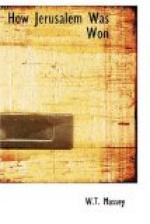Having dealt with the failure of the Turkish attacks against the 60th and 53rd Divisions in front of Jerusalem, let us change our view point and focus attention on the left sector of XXth Corps, where the enemy was feeling the full power of the Corps at a time when he most wished to avoid it. General Longley had organised his attacking columns in three groups. On the right the 229th Brigade of the 74th Division was set the task of moving from the wadi Imeish to secure the high ground of Bir esh Shafa overlooking Beitunia; the 31st Brigade, starting from near Tahta, attacked north of the wadi Sunt, to drive the enemy from a line from Jeriut through Hafy to the west of the olive orchards near Ain Arik; while the left group, composed of the 29th and 30th Brigades, aimed at getting Shabuny across the wadi Sad, and Sheikh Abdallah where they would have the Australian Mounted Division on their left. The advance started from the left of the line. The 29th Brigade leading, with the 30th Brigade in support, left their positions of deployment at six o’clock, by which time the Turk had had more than he had bargained for north and east of Jerusalem. The 1st Leinsters and 5th Connaught Rangers found the enemy in a stubborn mood west of Deir Ibzia, but they broke down the opposition in the proper Irish style and rapidly reached their objectives. The centre group started one hour after the left and got their line without much difficulty. The right group was hotly opposed. Beginning their advance at eight o’clock the 229th Brigade had reached the western edge of the famous Zeitun ridge in an hour, but from this time onwards they were exposed to incessant artillery and machine-gun fire, and the forward movement became very slow. In five hours small parties had worked along the ridge for about half its length, fighting every yard, and it was not until the approach of dusk that we once more got control of the whole ridge. It was appropriate that dismounted yeomen should gain this important tactical point which several weeks previously had been won and lost by their comrades of the Yeomanry Mounted Division. Descending from the ridge the brigade gave the Turk little chance to stand, and with a bayonet charge they reached the day’s objective in the dark. At two o’clock, when the Turks’ final effort against Jerusalem had just failed, the 60th and 74th Divisions both sent in the good news that the Turkish commander was moving his reserve division from Bireh westwards to meet the attack from our left. Airmen confirmed this immediately, and it was now obvious that General Chetwode’s tactics had compelled the enemy to conform to his movements and that we had regained the initiative. At about ten o’clock the 24th Royal Welsh Fusiliers of the 231st Brigade captured Kh. ed Dreihemeh on the old Roman road a mile east of Tireh, and at eleven o’clock advanced to the assault of hill 2450, a little farther eastward. They gained the crest, but the enemy had a big force in the neighbourhood and counter-attacked, forcing the Welshmen to withdraw some distance down the western slope. They held this ground till 4.30 when our guns heavily bombarded the summit, under cover of which fire the infantry made another attack. This was also unsuccessful owing to the intense volume of fire from machine guns. The hill was won, however, next morning.




